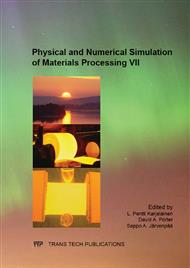p.9
p.14
p.22
p.31
p.38
p.47
p.55
p.62
p.70
The Thermomechanical Controlled Processing of High-Strength Steel Plate: A New View of Toughness Based on Modern Metallography
Abstract:
Modern thermomechanical controlled processing (TMCP) of advanced steels is now an important processing route in the production of engineering structures and products that are of value to society. The principles of TMCP are now practiced in the hot mill, cold mill and press forming shops around the world. Successful TMCP means that the proper metallurgical microstructure has been obtained in the required areas of the steel. The ideal microstructure is often defined by the correct phase balance and dimensions either of the parent austenite or final ferritic phase. Technological and economic demands have led to ever increasing levels of strength, especially for applications such as large diameter linepipe. The operative yield strengths in 18mm hot rolled plate have increased from X52(ferrite pearlite) in 1970 to X80(ferrite-bainite) today. The next frontier is the X100-X120 strength range, where bainitic or martensitic microstructures are required. It is clear that achieving a high-strength bainitic microstructure in heavy plate requires a high Carbon Equivalent value (C. E. II or Pcm), a rapid cooling rate, and a low water-end temperature. The requirement of high toughness and good weldability also means a low carbon content. This paper will describe the results of a research program where a steel of C. E. 0.56 and Pcm 0.23 was reheated, rough rolled for grain refinement, finish rolled for austenite pancaking, and direct quenched to below the Bs temperature. It was found that the strength and especially the toughness of the fully processed plates could not be explained using conventional metallographic techniques in conjunction with known structure-property relationships. However, the application of modern metallographic techniques based on FEG-SEM incorporating OIM led to microstructural characterization that more fully explained the observed mechanical properties. Of particular importance were the amount of MA micro-constituent, the crystallographic packet size of the bainite, and the high angle boundary character, especially the CSL boundaries, found in the microstructure. In the future, improved modeling of microstructural evolution and attendant mechanical properties will incorporate these important features.
Info:
Periodical:
Pages:
38-46
Citation:
Online since:
July 2013
Authors:
Price:
Сopyright:
© 2013 Trans Tech Publications Ltd. All Rights Reserved
Share:
Citation:


